Brand health is critical to the success of any business, yet many of them struggle to understand how well their brands are truly doing. They invest in marketing campaigns, but they don’t have a reliable way to track their impact on branding.
If this sounds familiar, then maybe you’re due for a brand health tracking.
What is Brand Health?
Brand health is the overall condition or state of a brand, measured by consumer awareness, perception, loyalty, and reputation.
Companies realized that a strong brand was a key differentiator that could allow them to charge premium prices and earn loyalty. They needed a way to measure and manage this. Enter brand health, a strategic tool that can signal when something is wrong before a brand declines and loses ground to competitors.
Why Track Brand Health
Tracking brand health can benefit companies by helping them strategize efficiently and effectively while avoiding losses.
1. It encourages evidence-based planning
Continuous monitoring of brand metrics like awareness, reach, perception, sales, and consumer behavior leads to data-backed strategies and marketing campaigns that deliver positive results.
2. It helps avoid losses
Brand health tracking helps detect shifts and challenges before they become serious. This guides brands to invest resources wisely and prevent potential losses.
12 Brand Health Metrics to Track
Brand health tracking is a complex process. It relies on a handful of metrics measured over time to gain significant insights for understanding the overall state of a brand.
Net promoter score (NPS) and CSAT
The Net Promoter Score (NPS) indicates how likely a brand is to be recommended to others, calculated by asking customers to rate the brand from one to 10. Low scorers are detractors, while high scorers are promoters. NPS is often paired with the Customer Satisfaction (CSAT) score, which gauges sentiment towards products and services. Higher CSAT means higher NPS, which is a good indicator for increasing loyalty.
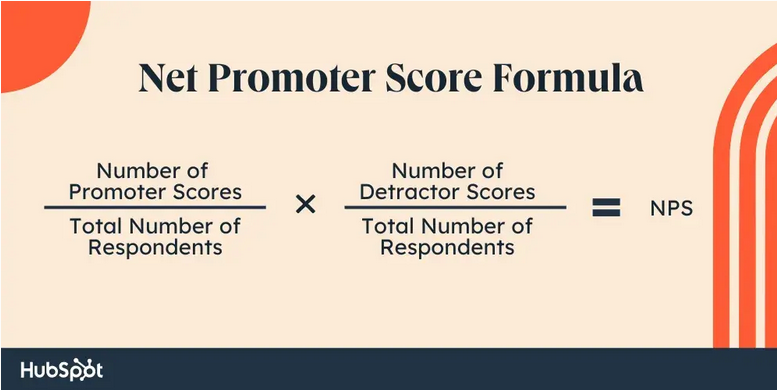
Net Promoter Score formula via Hubspot
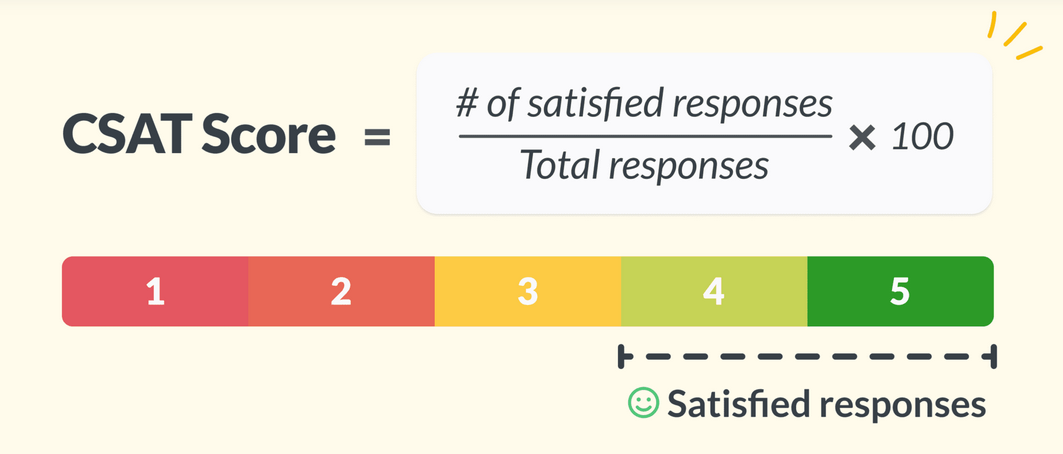
CSAT Score formula via Simplesat
Share of voice
Share of Voice (SOV) tracks media spending—ads, social media campaigns, events, etc. — and how well these investments are likely to perform relative to the number of conversations about your brand in a given space and period.
When measuring SOV, you can assign a specific metric to your brand and divide it by the total market share metrics. For instance, you can use web visits as your metric to track the effectiveness of SEO. This makes Share of Voice a crucial tool that can aid brands in allocating budgets to strategies with high returns.
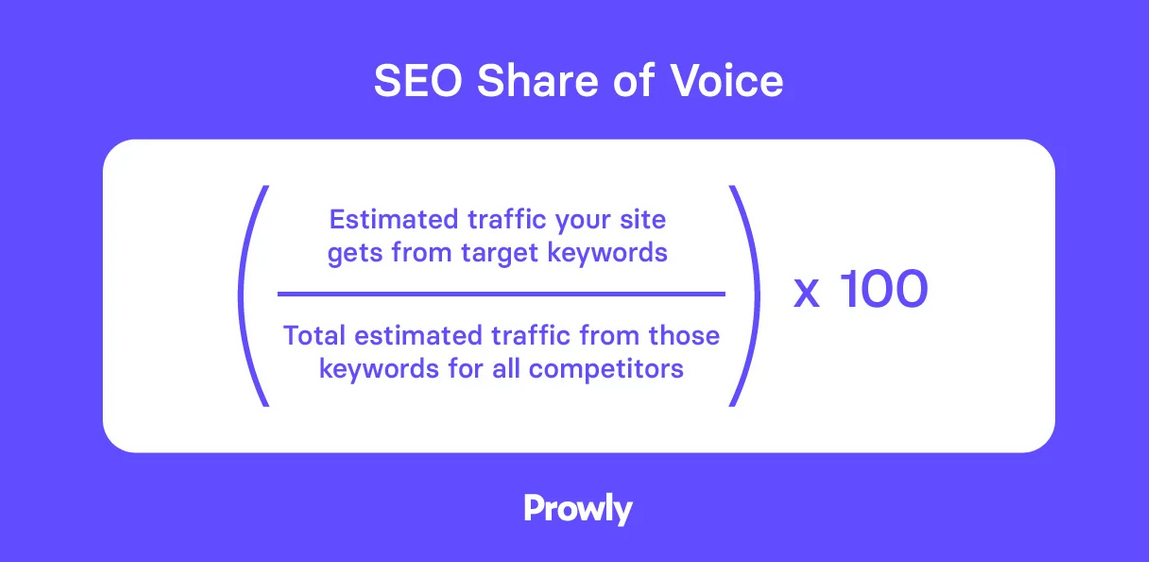
Share of Voice formula targeting SEO via Prowly
Brand sentiment and reputation
Brand sentiment tracks the emotional perception of customers towards your brand. It can be positive or negative, like love, hate, or annoyance. Meanwhile, brand reputation is the overall opinion people have of you. A brand that has been around for decades and consistently leads in its industry can have a solid reputation for being reliable and trustworthy.
Sentiment can shift quickly, while reputation evolves gradually. Consistent positive brand sentiment leads to a stronger brand reputation.
Brand recall (prompted and unprompted)
Brand recall is how well people remember your brand. Prompted recall requires visual and auditory cues, like a brand logo, a branded jingle, or a packaging. Unprompted recall refers to a customer thinking of a brand in a specific category. For instance, if a customer is thinking of buying a toothpaste, Colgate immediately comes to mind.
An increase in unprompted recall signifies high brand awareness.
Purchase intent
Purchase intent tracks how likely potential customers are to buy from a brand. High intent means trust and a willingness to convert soon. Purchase intent can also inform companies about their production quantity. For instance, if there is a strong purchase intent for a camera model, the company would make more of it.
Brand equity
Brand equity is the value a brand brings to customers. It addresses questions like, “How do its products and services improve the life of end-users?” or “Why should a person choose a brand over others?”
Equity is built through consistently delivering quality service and products, good customer experiences, and fostering emotional connections over time. A strong brand equity can shield brand health should crises arise.
Brand loyalty
Brand loyalty is shaped by customer satisfaction, emotional connection, competition, and consistent communication. A brand that is doing well is more likely to foster a community of loyal customers. These loyal customers keep the brand alive by continuously supporting and referring it to people in their circle. In effect, brand loyalty brings in more business, paving the way for a healthier brand.
Brand preference and usage
Brand preference refers to how strongly people will choose a brand over others, while brand usage is how often people actually buy from a brand and use their products or services.
Brand preference is strengthened by a brand’s appeal, emotional connection, and loyalty. For instance, Apple has a strong following for its iPhone products. On the other hand, brand usage demonstrates buying behavior, as those who like the brand tend to buy from it.
A high level of brand preference and usage indicates customer trust and support.
Brand uplift
Brand uplift tracks the progression of a brand, like an increase in awareness, preference, or loyalty after the launch of a marketing campaign. For example, Coca-Cola’s Open Happiness campaign increased emotional connection and user engagement.
Tracking brand uplift helps marketers understand the effectiveness of their efforts and translate them into stronger customer relationships and business growth.
Social reach and time on site
Social reach indicates how widely popular or visible your brand is online. The bigger the social reach, the higher the visibility. Time on site refers to the duration a visitor typically spends engaging with your website. The longer a visitor stays, the higher the interest and the likelihood of converting into a buying customer.
Returning visitors
The number of returning visitors a website has is the ultimate indicator of whether people like your brand enough to come back again. This reflects a growing interest, trust, better engagement, and stronger equity as consumers find your products and services useful.
Aside from tracking the number of returning visitors, you also need to consider the time spent on site, repeat purchases, and Customer Lifetime Value (CLV).
Employee engagement
Employees are likely to take the initiative to talk positively about your brand in and out of the workplace when you foster a healthy working environment. This can be done through offering growth opportunities, enrichment programs, and providing flexible work options.
When everyone on the team feels cared for, they perform better and turn into brand advocates—all of which strengthen brand health.
6 Ways to Measure Brand Health
Tracking and understanding your brand health requires utilizing the right measurements and tools.
Consumer reach and surveys
Higher consumer reach leads to increased brand awareness and recall. This can be measured by conducting aided and unaided surveys to assess recall and recognition. That said, survey periodically as consumer reach may fluctuate.
Social media listening and web analytics
Combine data from consumer reach surveys with social media and data analytics insights for a comprehensive view of brand health.
Most social media platforms have built-in analytics tools you can use to find out the number of shares, likes, and comments. They also capture clicks and whether feedback and posts about your brand are positive or negative. Moreover, you can use web analytics tools to see how many users your website is attracting and analyze which content performs best.
Bespoke brand tracking studies
Customizing research studies around a brand goal, shedding light on how people perceive your brand, their level of loyalty, and how you compare to other competitors. For example, if an ice cream company wants to know if its summer flavors are doing well in the market, it can create a customized research study that delves into key brand health metrics, including brand awareness, brand consideration, and brand perception of its target audience.
An effective bespoke brand tracking study combines quantitative and qualitative data. You should also monitor emotional responses to your brand to see if the messaging still connects well with your audience.
Brand awareness and perception
Brand awareness can vary, from no awareness to top-of-mind. That said, you can use prompted and unprompted survey tools to see where customers are in terms of brand familiarity.
For brand perception, you can leverage structured surveys that explore how people feel about your brand. You can ask questions like, “What comes to mind when you see an ad from Brand X?” Other tools to explore include social media monitoring and sentiment analysis.
Brand attributes and associations
Brand attributes are features that people relate to your brand. IKEA is known for being simple yet chic, modern, and sustainable. Brand associations are emotions and ideas people think when they encounter your brand. Nike evokes a sporty, passionate, and highly motivated image.
You can identify these attributes and associations using surveys and research tools that dig deeper into the minds and hearts of your target audience.
Brand positioning and message testing
Sometimes, misalignment happens between brand positioning and message when customer needs and competition evolve. This leads to ineffective campaigns and a disconnected audience, resulting in poor brand health.
This is where regular brand positioning and message testing become crucial. It allows you to monitor changes in customer needs and expectations, competition, and industry, enabling you to calibrate your strategies and branding accordingly.
X+O data integration
Integrating Experience (X) data and Operational (O) data provides deeper insights into how customer experiences impact your business.
X data tracks feedback from customers and employees, like social conversations and satisfaction scores. O data encompasses business metrics like sales, website traffic, and inventory levels.
By combining X + O data, you can identify and track how specific decisions and customer experiences translate into real-world outcomes. For example, if sales decline, you can examine customer feedback to understand what’s behind the drop and make targeted improvements, especially to your customer experience strategies.
You can gather X data through surveys, interviews, focus groups, and social media listening tools. As for O data, you can refer to performance reports, including those on marketing and sales, financial performance, and projects.
Brand Health Diagnostic Tools
Establishing a brand health program requires setting clear objectives and prioritizing relevant brand health metrics to track. It’s also vital to use the right tools to get a comprehensive view and analysis of your current brand health.
1. Brandwatch
Brandwatch is a consumer intelligence and social media management platform that collects and tracks information about a brand from social media, blogs, forums, and other websites. It provides data-backed analyses and trends that users can use to monitor awareness, loyalty, and public opinion, among other factors.
Key features:
- Brand sentiment analysis
- In-depth data coverage and analysis
- Intuitive user dashboard
- Leverages AI and NLP
- Social media management tools
- Comprehensive data visualization and reporting tools
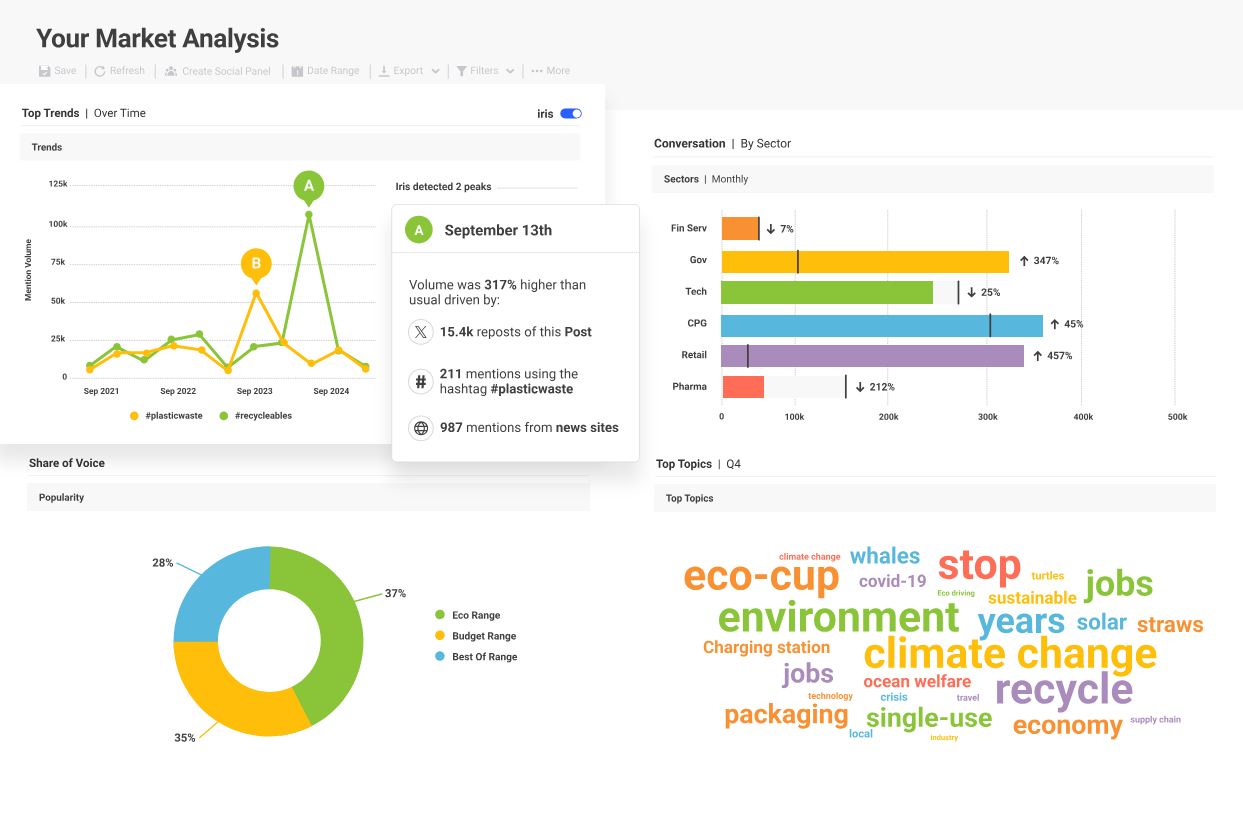
Sample market analysis overview by Brandwatch
2. Qualtrics
Qualtrics specializes in helping users create surveys that effectively gather feedback. It focuses on monitoring social media and online conversations, making Qualtrics a competitive tool for analyzing direct customer responses. You can use Qualtrics in tandem with Brandwatch to gain deeper and structured feedback from specific groups.
Key features:
- Competitive benchmarking
- Sentiment and text analysis
- Real-time customer feedback collection
- Social media integration
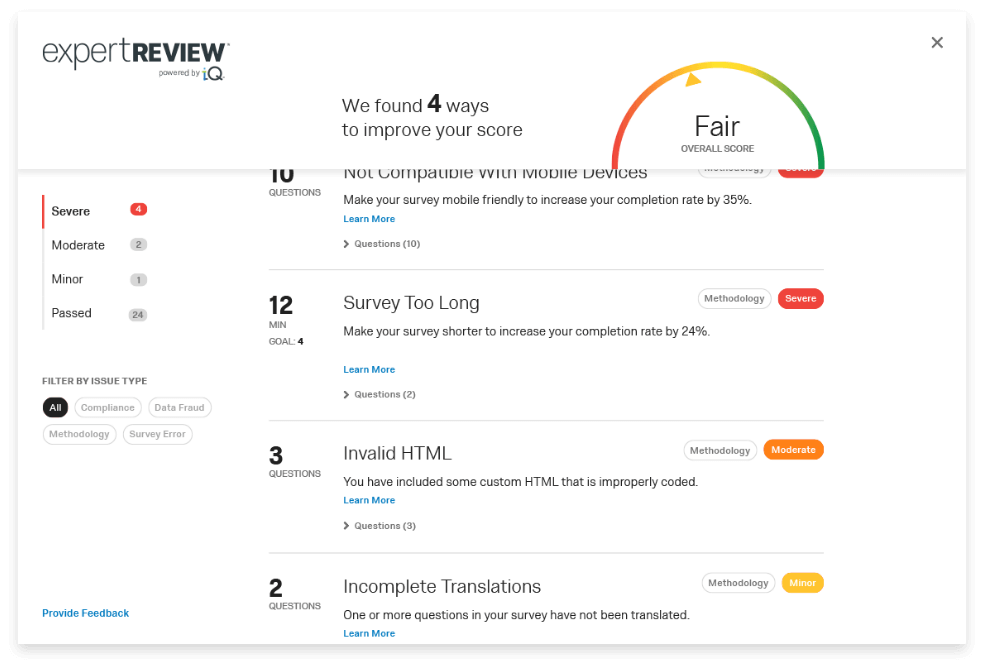
Customer survey review capabilities via Qualtrics
3. Social listening tools
Social listening tools help monitor what people say about your brand through comments, reviews, and mentions. This ensures you’re up to speed with their top concerns so you can address them on time. Listening to your customers is the easiest way to monitor brand health and demonstrate concern by developing innovative solutions to their issues.
Examples of social listening tools you can use include Sprout Social and Hootsuite. Aside from social listening capabilities, these platforms allow brands to create and manage social content and track brand performance in real-time.
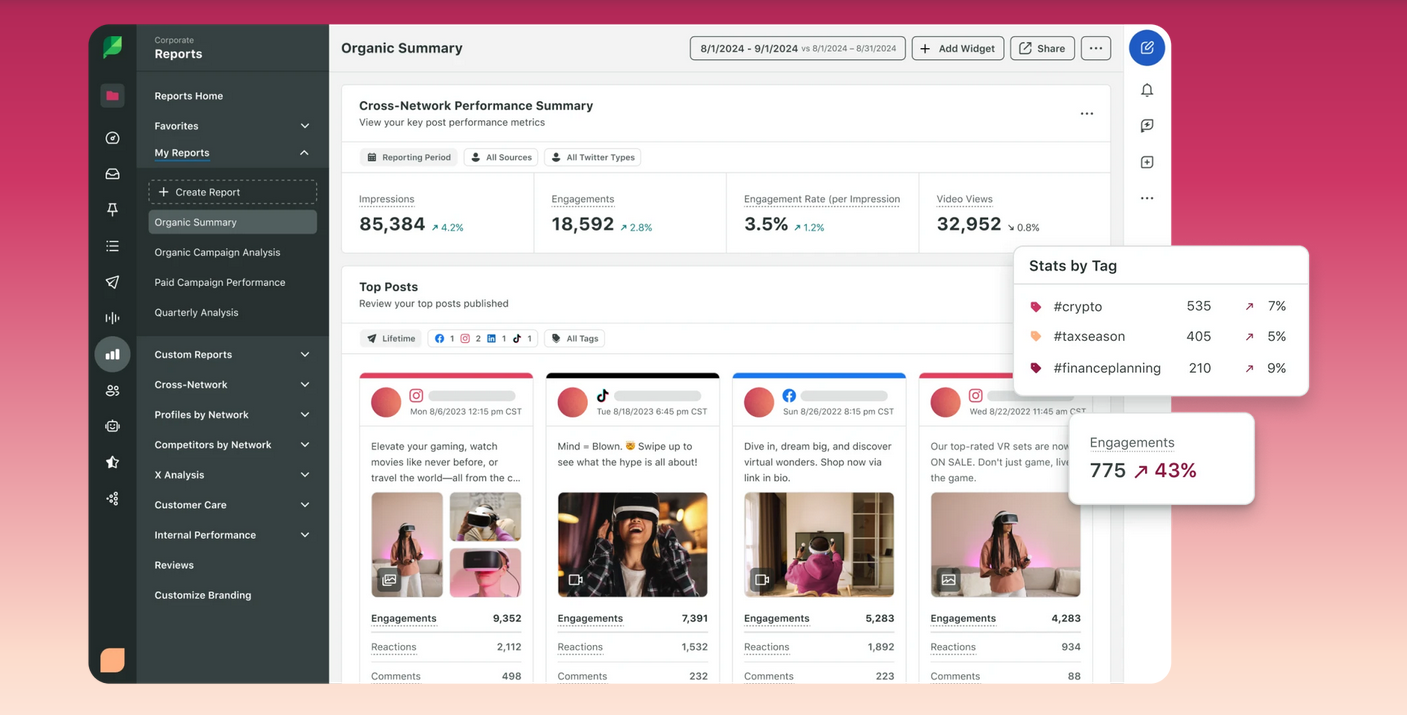
Social media performance summary via Sprout Social
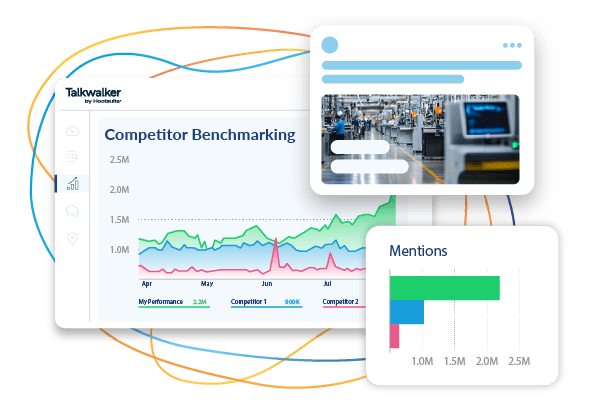
Social media listening tools via Hootsuite
Aside from having the right tools, it is essential to work with a team of experts, like these top branding companies, to address and assess your brand health needs.
How to Heal a Sick Brand
So, what do you do once you know your brand is in a poor state? Below are some foundational steps you can take to ensure brand strength.
Get the right diagnosis
Before you can start the healing process, you need to know what brand “illness” you’re struggling with. Ask customers what they feel and think about your brand. Dig deeper into why they will or will not recommend you to others, so you have a concrete idea of where to focus your efforts for improvement.
That said, run diagnostics regularly. For instance, you can do it every quarter or before, during, and after a marketing campaign.
Set turnaround goals and action plan
Implementing solutions to heal a brand requires a structured approach. So, establish SMART (specific, measurable, achievable, relevant, and timely) goals. Follow through with an action plan by breaking goals into smaller milestones to make progress easier to accomplish.
Measure progress
With every intervention, don’t forget to keep track of your brand health. Use tools that monitor key metrics, like brand sentiment, awareness, perception, and customer retention rates. If something isn’t improving, adjust your plan quickly before problems get out of hand.
Get Your Brand Health Checked
Assessing brand health is crucial for businesses of any size. You don’t need fancy tools or an expensive team to get started. You can start by listening to customer feedback, monitoring social media, and analyzing sales data.
Over time, invest in more comprehensive brand health diagnostic tools to gain deeper insights. Or better yet, work with a reliable branding agency that can cover all the bases and help you get ahead of the competition.
Your brand is an evolving entity that requires constant care and attention. So, keep everything in check to ensure it remains relevant and competitive for a healthy brand. Prevention is always better than cure.
Oct 17, 2025
